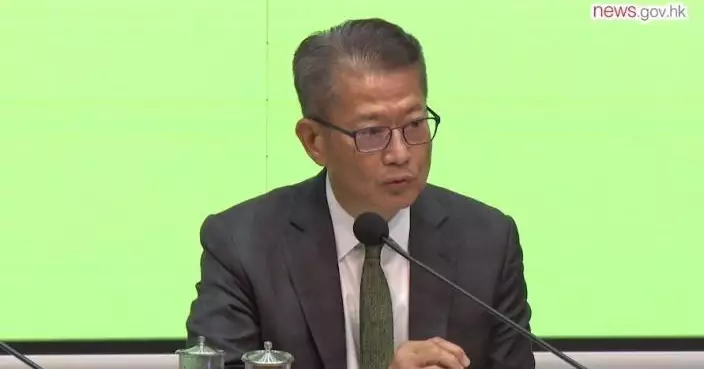Transcript of remarks by SDEV at media session
Following is the transcript of remarks by the Secretary for Development, Ms Bernadette Linn, at a media session after attending a radio programme today (July 20):
Reporter: Now that the threshold for compulsory land sale has been lowered, besides setting up designated offices, what other measures or support would be in place to help affected flat owners? Specifically, would the government consider building new buildings within the same district to accommodate them? Secondly, over the San Tin Technopole development, you mentioned that the government is considering allowing developers who win bid for a land to take on the responsibility of forming land, could you explain the rationale behind this decision and whether there is a concrete plan for how much of the area would be developed with this approach.
Secretary for Development: On your first question regarding the compulsory sales, first of all, I must make it very clear that the compulsory sale regime is to facilitate the redevelopment of our aged buildings in the private market. So it is activities in the private market, activities between the private owners of individual flats and those developers who are interested in acquiring their flats. So there is no question of government going into this market and having flats built to rehouse those owners affected. It is a private market activity. Of course, the government has also been rolling out land and the Urban Renewal Authority has also been taking forward redevelopment projects in the urban area. That means there will be new flats in the urban area anyway to help with the decanting with the movement of the owners out of their aged buildings. But again, this is a private activity to happen or happening in the private market, not about government intervention of building private housing for rehousing.
As to what type of support we will give to the minority owners affected by compulsory sale applications, we will be shortly establishing a dedicated support centre. This centre will report to the Development Bureau, so it is a government-led setup. And this centre will provide support for the minority owners in terms of legal advice and independent valuation advice which they will need to tackle the compulsory sale applications. We will also engage the Urban Renewal Authority to invite them to help promote the joint sales among owners who would like to join together and have their flats redeveloped without having to wait for developers to approach them. So we will use a multi-pronged approach to assist minority owners.
As to your second question about the use of this new concept in developing the Northern Metropolis, it may not necessarily be applied to the San Tin Technopole. But this new concept is about the government designated a rather large region in the Northern Metropolis and having that region tendered out to a consortium and require the consortium to deliver what the government required of that land, including private residential, commercial gross floor area and also infrastructure and community facilities. This approach will help reduce the cash flow burden on the government because we do not have to use the public coffers, use public funding to do the site formation and other infrastructure on our own. Whoever is the consortium successfully tendering the land for that region, they will make a bid and in that bid they will take account of the capital cost that they have to incur and give the government a reasonable revenue, so we think it will help in terms of speed and also in terms of government cash flow.
(Please also refer to the Chinese portion of the transcript.)

Source: AI-generated images
Monetary Authority announces countercyclical capital buffer ratio for Hong Kong
The following is issued on behalf of the Hong Kong Monetary Authority:
The Monetary Authority announced today (October 18) that the countercyclical capital buffer (CCyB) ratio for Hong Kong is reduced from 1 per cent to 0.5 per cent with immediate effect.
The Monetary Authority, Mr Eddie Yue,said, "While the local economy has continued to recover, the risk of economic overheating is well contained as suggested by the quantitative indicators. Facing changes in the market landscape, certain sectors in the domestic economy, in particular the SMEs, are nevertheless still seeing challenges in their business operations amid uncertainties in the external and local economic environment. It is therefore appropriate to reduce the CCyB moderately to allow banks to be more supportive to Hong Kong’s economy. Together with the other measures already introduced by the HKMA to support SMEs, we expect banks to make use of the additional leeway provided by the lower CCyB to further facilitate the financing needs of local SMEs. A gradual increase in the CCyB for Hong Kong will only be considered in the future when data suggest that there is more broad-based growth in the domestic economy and when the credit and property market conditions suggest a higher CCyB is warranted."
Further details of the decision may be found in the Announcement of the CCyB to Authorized Institutions on the HKMA website.
Background
In setting the CCyB ratio the Monetary Authority considered a series of quantitative indicators and qualitative information including an "indicative buffer guide" (which is a metric providing a guide for CCyB ratio based on the gap between the ratio of credit to GDP and its long term trend, and between the ratio of residential property prices to rentals and its long term trend). The latest indicative buffer guide calculated based on 2024Q2 data and the Positive Neutral CCyB (Note)according to the revised formula, signals a CCyB of 1 per cent. The projection based on all available data suggests that the indicative buffer guide would likely signal a CCyB of 1 per cent when all relevant 2024Q3 data become available.
The indicative buffer guide, as its name suggests, provides only a "guide" for CCyB decisions, and the determination of the jurisdictional CCyB ratio for Hong Kong is not a mechanical exercise. In addition to the indicative buffer guide, the Monetary Authority also reviewed other relevant information. While the local economy has continued to recover, the risk of economic overheating is well contained as suggested by quantitative indicators. Facing changes in the market landscape, certain sectors in the domestic economy, in particular the SMEs, are nevertheless still seeing challenges in their business operations amid uncertainties in the external and local economic environment. Together with the other measures already introduced by the HKMA to support SMEs, a lower CCyB will provide banks with additional leeway to further facilitate the financing needs of local SMEs.
The CCyB is an integral part of the Basel III regulatory capital framework and is being implemented in parallel by Basel Committee member jurisdictions worldwide. The CCyB has been designed by the Basel Committee to increase the resilience of the banking sector against system-wide risks. The banking sector can then act as a "shock absorber" in times of stress, rather than as an amplifier of risk to the broader economy.
The power to implement the CCyB in Hong Kong is provided by the Banking (Capital) Rules, which enable the Monetary Authority to announce a CCyB ratio for Hong Kong. The specific CCyB requirement applicable to a given Authorized Institution (AI) is expressed as a percentage of its CET1 capital to its total risk-weighted assets (RWA). Each AI’s CCyB requirement may vary depending on the geographic mix of its private sector credit exposures and the CCyB applicable in each jurisdiction where it has such exposures.
Note: Under the Positive Neutral CCyB approach, authorities aim for a positive CCyB when risks are judged to be neither subdued nor elevated. Please refer to www.bis.org/publ/bcbs_nl30.htm for more information.








